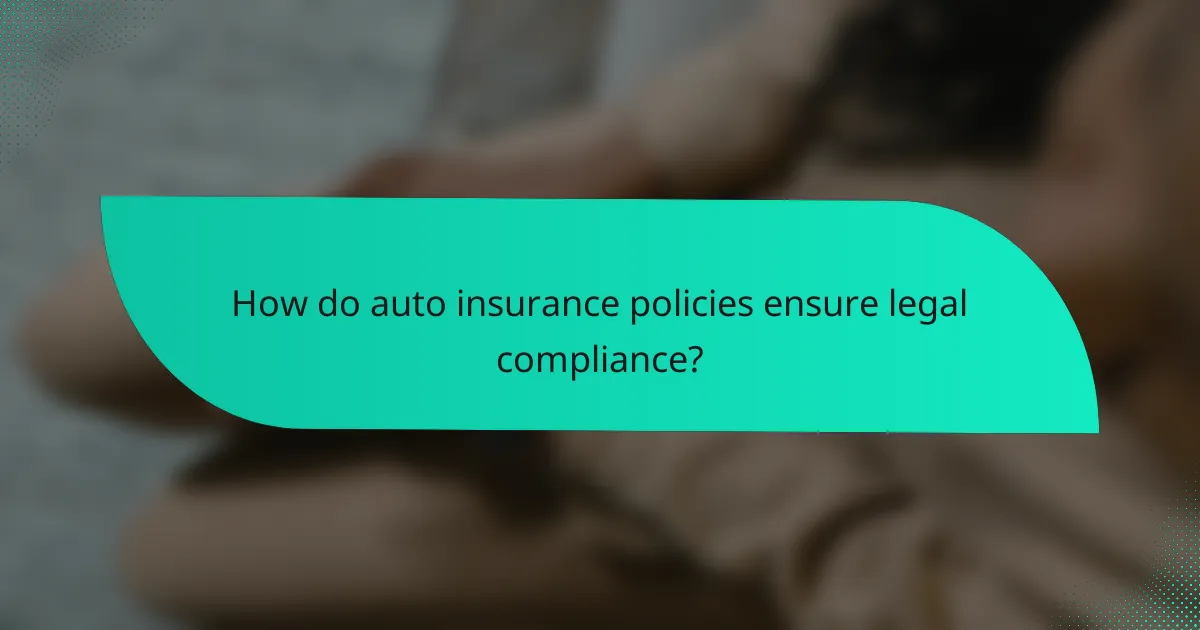Auto insurance policies are essential for providing accident protection, covering various costs associated with vehicle incidents and ensuring financial security. They offer peace of mind by reducing stress related to potential liabilities and ensuring legal compliance with state regulations. With the right coverage, drivers can confidently navigate the roads, knowing they are protected from unexpected events.

How do auto insurance policies provide accident protection?
Auto insurance policies offer accident protection by covering various costs associated with vehicle accidents, ensuring financial security and legal compliance. These policies typically include several types of coverage that address different aspects of accident-related expenses.
Liability coverage
Liability coverage is essential for protecting you against claims made by others if you are at fault in an accident. It typically covers bodily injury and property damage, helping to pay for medical expenses and repairs incurred by the other party. Most states require a minimum level of liability coverage, so it’s crucial to understand your local regulations.
When selecting liability limits, consider your assets and potential legal costs. Higher limits provide better protection but may also increase your premium. A common recommendation is to carry coverage that exceeds state minimums to safeguard your financial future.
Collision coverage
Collision coverage helps pay for repairs to your vehicle after an accident, regardless of who is at fault. This type of coverage is particularly valuable for newer or more expensive cars, as repair costs can be significant. It typically covers damages from collisions with other vehicles or objects.
When choosing collision coverage, assess your vehicle’s value and your budget. If your car is older and worth less than your deductible, it may not be cost-effective to maintain this coverage. However, if you rely on your vehicle for daily transportation, collision coverage can provide peace of mind.
Comprehensive coverage
Comprehensive coverage protects against non-collision-related incidents such as theft, vandalism, or natural disasters. This coverage is essential for safeguarding your vehicle from unforeseen events that could lead to significant financial loss. It complements collision coverage by addressing a broader range of risks.
Consider comprehensive coverage if you live in an area prone to severe weather or high crime rates. While it adds to your premium, it can save you from substantial out-of-pocket expenses in the event of a covered loss.
Personal injury protection
Personal injury protection (PIP) covers medical expenses for you and your passengers, regardless of fault. This type of coverage can include hospital bills, rehabilitation costs, and even lost wages due to injury. PIP is mandatory in some states, while in others, it is optional.
Evaluate your health insurance coverage when deciding on PIP. If you have robust health insurance, you might opt for lower PIP limits. However, having PIP can be beneficial for quick access to funds for medical treatment after an accident.
Uninsured motorist coverage
Uninsured motorist coverage protects you if you’re involved in an accident with a driver who lacks insurance or has insufficient coverage. This type of policy ensures that you are not left with significant expenses due to another party’s negligence. It can cover medical bills and damages to your vehicle.
Consider adding uninsured motorist coverage, especially if you live in an area with a high percentage of uninsured drivers. This coverage can provide critical financial protection and peace of mind, ensuring you are not left vulnerable on the road.

What is the peace of mind offered by auto insurance?
Auto insurance provides peace of mind by ensuring financial protection against accidents, reducing stress associated with potential liabilities, and offering legal compliance. This coverage allows drivers to navigate the roads with confidence, knowing they are safeguarded from unexpected events.
Financial security
Financial security through auto insurance means that in the event of an accident, the costs associated with vehicle repairs, medical expenses, and liability claims are covered. This can prevent significant out-of-pocket expenses that could otherwise lead to financial strain.
For example, if a driver causes an accident resulting in damages of several thousand dollars, their insurance can cover these costs, protecting their savings. Choosing a policy with adequate coverage limits is crucial to ensure sufficient protection.
Stress reduction
Having auto insurance significantly reduces stress by alleviating worries about the financial implications of accidents. Knowing that you have a safety net allows drivers to focus on the road rather than potential mishaps.
Additionally, many insurance policies offer roadside assistance and rental car coverage, which can further ease the burden during emergencies. This support can save time and provide peace of mind, knowing help is just a phone call away.
Legal protection
Legal protection is a critical aspect of auto insurance, as it ensures compliance with state laws requiring minimum coverage. Driving without insurance can lead to severe penalties, including fines and license suspension.
In many regions, liability coverage is mandatory, and having auto insurance helps drivers avoid legal troubles. Furthermore, if a driver is sued after an accident, their insurance can cover legal fees and settlements, providing essential protection against costly legal battles.

How do auto insurance policies ensure legal compliance?
Auto insurance policies ensure legal compliance by meeting minimum coverage standards set by state regulations. These policies protect drivers from financial liability in case of accidents, ensuring that they adhere to the law while driving.
Minimum coverage requirements
Minimum coverage requirements vary by state but generally include liability insurance for bodily injury and property damage. For instance, many states require at least $25,000 for bodily injury per person and $50,000 per accident, along with $10,000 for property damage.
Drivers should check their local laws to understand the specific minimums applicable in their state. Failing to meet these requirements can result in fines, license suspension, or other legal penalties.
State-specific regulations
Each state has its own regulations regarding auto insurance, which can affect coverage types and limits. Some states, like California, require additional coverage options such as uninsured motorist protection, while others may have unique requirements for commercial vehicles.
Understanding these state-specific regulations is crucial for drivers to ensure they are fully compliant and adequately protected. Regularly reviewing state laws can help avoid lapses in coverage or unexpected legal issues.
Proof of insurance documentation
Proof of insurance documentation is necessary to demonstrate compliance with state laws. Most states require drivers to carry an insurance card that provides details about their coverage, including the insurer’s name, policy number, and effective dates.
Drivers should keep this documentation in their vehicles at all times, as law enforcement may request it during traffic stops or accidents. Additionally, some states allow digital proof of insurance, which can be accessed via mobile apps or email, providing a convenient alternative to physical cards.

What factors influence auto insurance policy pricing?
Auto insurance policy pricing is influenced by several key factors that assess risk and potential costs. These include the driver’s age and experience, the type and model of the vehicle, and the driver’s location and driving history.
Driver’s age and experience
The age and driving experience of the policyholder significantly impact insurance rates. Generally, younger drivers, particularly those under 25, face higher premiums due to their inexperience and higher accident rates. Conversely, older, more experienced drivers often benefit from lower rates.
Insurance companies may also consider the number of years a driver has held a license. A longer driving history with fewer claims can lead to discounts, while a recent license may result in higher costs.
Vehicle type and model
The make and model of a vehicle play a crucial role in determining insurance costs. Cars that are more expensive to repair or replace, or those known for high theft rates, typically incur higher premiums. For example, luxury vehicles and sports cars often attract higher rates than standard sedans.
Additionally, vehicles with advanced safety features may qualify for discounts, as they are less likely to be involved in accidents. When choosing a car, consider its insurance costs alongside its purchase price.
Location and driving history
Your location can greatly affect your auto insurance rates. Areas with high traffic congestion or elevated crime rates often lead to higher premiums. For instance, urban dwellers may pay more than those in rural areas due to increased risk of accidents and theft.
Driving history is equally important; a record with multiple accidents or traffic violations can lead to significantly higher rates. Maintaining a clean driving record is essential for keeping insurance costs manageable. Regularly reviewing your policy and shopping around can help you find better rates based on your location and driving history.

How to choose the right auto insurance policy?
Choosing the right auto insurance policy involves evaluating your coverage needs, comparing quotes, and understanding policy terms. This process ensures you find a plan that offers adequate protection, peace of mind, and compliance with legal requirements.
Assessing coverage needs
Start by determining the level of coverage you require based on your vehicle’s value, your driving habits, and local regulations. Consider factors such as liability coverage, collision, and comprehensive insurance to protect against various risks.
For instance, if you own a newer or high-value car, opting for full coverage may be wise. Conversely, older vehicles might only need liability coverage, which is often the minimum required by law.
Comparing quotes from providers
Gather quotes from multiple insurance providers to ensure you receive competitive rates. Use online comparison tools or contact agents directly to get a clearer picture of your options.
When comparing quotes, pay attention to the coverage limits and deductibles. A lower premium might come with higher out-of-pocket costs in the event of a claim, so balance price with the level of protection offered.
Understanding policy terms
Read and comprehend the terms of each policy carefully. Key elements to focus on include exclusions, coverage limits, and the claims process. Understanding these details can prevent surprises when you need to file a claim.
Look for common terms like “actual cash value” versus “replacement cost,” as they significantly impact how much you receive in a claim. Make sure to clarify any confusing language with your insurance agent before making a decision.

What are the benefits of bundling auto insurance with other policies?
Cost Savings
One of the primary benefits of bundling auto insurance is the potential for cost savings. Many insurance companies offer discounts ranging from 10% to 25% when multiple policies are purchased together. This can result in substantial annual savings, especially for families with multiple vehicles or homes.
When considering bundling, it’s essential to compare the bundled rate against individual policy costs. Sometimes, the savings from bundling may not be as significant if the individual policies are already competitively priced. Always request quotes for both options to make an informed decision.
Convenience
Bundling auto insurance with other policies simplifies the management of your insurance needs. Instead of dealing with multiple providers and payment schedules, you can handle everything through one insurer. This can save time and reduce the likelihood of missed payments.
Additionally, having a single point of contact for claims and inquiries can enhance your overall experience. If you encounter issues or need assistance, you can resolve them more efficiently with one provider rather than navigating multiple customer service channels.
Enhanced Coverage Options
Bundling can also provide access to enhanced coverage options that may not be available with standalone policies. For example, some insurers offer additional benefits, such as roadside assistance or rental car reimbursement, when policies are bundled. This can improve your overall protection and peace of mind.
It’s important to review the specific coverage details of bundled policies. Ensure that the combined coverage meets your needs and that you are not sacrificing essential protections for the sake of convenience or savings. Always read the fine print to understand what is included and what is not.
